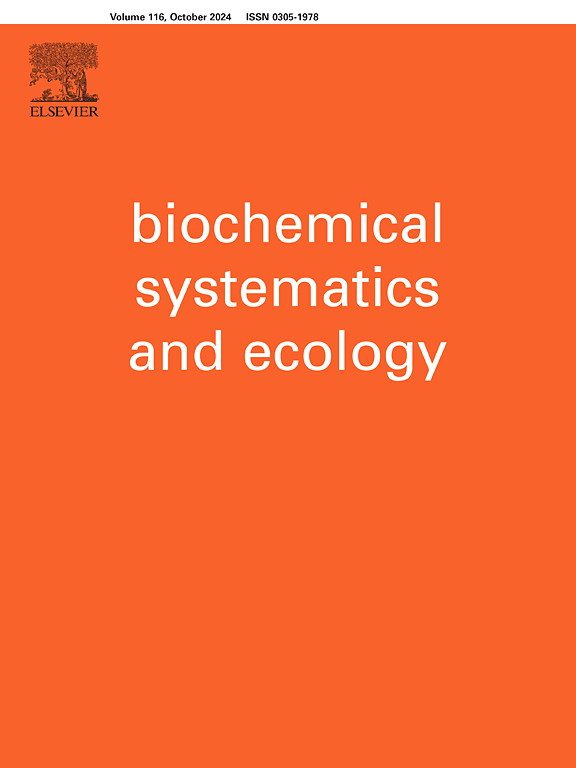Ochna afzelii R. Br. (ex Oliv.)
IF 1.4
4区 生物学
Q4 BIOCHEMISTRY & MOLECULAR BIOLOGY
引用次数: 0
摘要
对 Ochna afzelii R. Br. (ex Oliv.) 分离出 14 种已知的次生代谢物,包括两种二聚查耳酮,即二氢罗非酮 M (1) 和罗非酮 L (2);两种重新排列的双黄酮类化合物:罗非酮 A (3) 和 4‴-甲氧基罗非酮 A (4);两种双黄烷酮衍生物:双黄烷酮 I (5) 和双黄烷酮 II (6);两种异黄酮类化合物:甲基鸢尾素 (7) 和生物黄酮素 (8):一种黄烷醇:表儿茶素 (9);一种酚酸:3,4-二羟基苯甲酸 (10);一种蒽醌:physcion (11);两种三萜类化合物:羽扇豆醇 (12) 和齐墩果酸 (13);以及一种类固醇:西固醇-3-O-β-d-吡喃葡萄糖苷 (14)。本文首次报道了木犀科植物中的 Biochanin A(8)和 3,4-二羟基苯甲酸(10)。对大肠杆菌、绿脓杆菌、金黄色葡萄球菌和粪肠球菌等致病菌株的抗菌活性进行了体外评估。粗甲醇提取物及其丙酮溶性和不溶性馏分显示出高度至显著的抗菌活性,而分离出的化合物大多显示出中等抗菌活性(MIC = 16-64 μg/mL)。本文章由计算机程序翻译,如有差异,请以英文原文为准。
Chemophenetic significance and antibacterial activity of extract, various fractions and secondary metabolites from the stem bark of Ochna afzelii R. Br. (ex Oliv.)
Chemical investigation of the acetone-soluble sub-fraction of the methanolic extract of the stem bark of Ochna afzelii R. Br. (ex Oliv.) led to the isolation of fourteen known secondary metabolites comprising two dimeric chalcones namely dihydrolophirone M (1) and lophirone L (2), two rearranged biflavonoids: lophirone A (3) and 4‴-methoxylophirone A (4), two biflavanone derivatives: biflavanone I (5) and biflavanone II (6), two isoflavonoids: methylirisolin (7) and biochanin A (8), one flavanol: epicatechin (9), one phenolic acid: 3,4-dihydroxybenzoic acid (10), one anthraquinone: physcion (11), two triterpenoids: lupeol (12) and oleanolic acid (13), and one steroid: sitosterol-3-O-β-d-glucopyranoside (14). Biochanin A (8) and 3,4-dihydroxybenzoic acid (10) are herein reported for the first time from the family Ochnaceae. The antibacterial activity was assessed in vitro against pathogenic strains of Escherichia coli, Pseudomonas aeruginosa, Staphylococcus aureus and Enterococcus faecalis. The crude methanolic extract as well as its acetone-soluble and insoluble fractions exhibited high to significant antibacterial activity, while isolated compounds mostly displayed moderate antibacterial activity (MIC = 16–64 μg/mL).
求助全文
通过发布文献求助,成功后即可免费获取论文全文。
去求助
来源期刊

Biochemical Systematics and Ecology
生物-进化生物学
CiteScore
3.00
自引率
12.50%
发文量
147
审稿时长
43 days
期刊介绍:
Biochemical Systematics and Ecology is devoted to the publication of original papers and reviews, both submitted and invited, in two subject areas: I) the application of biochemistry to problems relating to systematic biology of organisms (biochemical systematics); II) the role of biochemistry in interactions between organisms or between an organism and its environment (biochemical ecology).
In the Biochemical Systematics subject area, comparative studies of the distribution of (secondary) metabolites within a wider taxon (e.g. genus or family) are welcome. Comparative studies, encompassing multiple accessions of each of the taxa within their distribution are particularly encouraged. Welcome are also studies combining classical chemosystematic studies (such as comparative HPLC-MS or GC-MS investigations) with (macro-) molecular phylogenetic studies. Studies that involve the comparative use of compounds to help differentiate among species such as adulterants or substitutes that illustrate the applied use of chemosystematics are welcome. In contrast, studies solely employing macromolecular phylogenetic techniques (gene sequences, RAPD studies etc.) will be considered out of scope. Discouraged are manuscripts that report known or new compounds from a single source taxon without addressing a systematic hypothesis. Also considered out of scope are studies using outdated and hard to reproduce macromolecular techniques such as RAPDs in combination with standard chemosystematic techniques such as GC-FID and GC-MS.
 求助内容:
求助内容: 应助结果提醒方式:
应助结果提醒方式:


